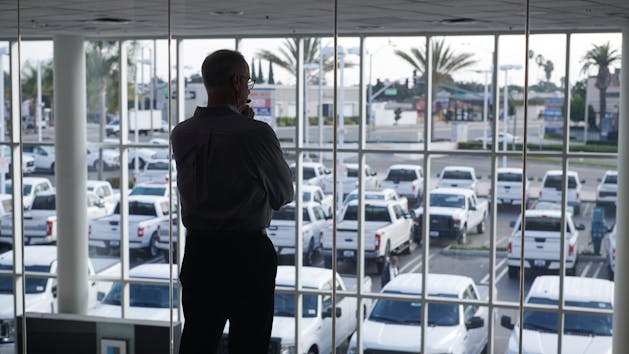Find the right solution for your business with our free Fleet Management Buyer’s Guide.
Signs You’re Ready to Implement Telematics
Though many dream of expanding and growing their business, once that growth comes, they can feel some heavy burdens that often accompany growth. For businesses that operate fleets, adding vehicles and employees can make the job of monitoring operations and expenses quite the headache, and some may even be adding to their fleets as a knee-jerk reaction to growth before there is truly a need to do so.
GPS fleet tracking can provide the data-based insight into your operations that helps you make educated business decisions as you reach for and manage growth to make the most of new business and even accelerate growth.
Expect growth
Owners of small- and medium-sized businesses are thriving in the current environment where technology is enabling them to compete with big names. According to Entrepreneur.com, “The internet, big data and the gig economy have lowered the barriers to entry for new businesses, paving the way for small, niche firms that can compete with certain aspects of large brand-name businesses. The world is running on scrappy small businesses that find new ways to compete and succeed.”
A 2016 Intuit report revealed that 70% of small businesses surveyed were using cloud technology and apps to run their businesses, seeing benefits like lower operational costs, streamlined processes and insights to make better decisions. The number of vehicles that have video systems is projected to grow 22% by 2020 to more than 1 million, according to Fleet Owner. With these capabilities in their pockets, the “little guys” are more competitive and profitable than ever.
According to a report from the NFIB Research Foundation, small business owners added the most workers per firm during the month of July since July 2006. In fact, Forbes.com says they’re having a hard time keeping up with demand in the tight labor market. In the current environment, where workers are in shortage yet growth is happening, owners must thoughtfully consider where to invest their resources and how those investments will impact other areas of the business.
Trim before you expand
But before expanding in any area, it’s critical to examine costs and trim where possible, to make as much capital available as you can to invest where you need to. Year after year, owners may notice their expenses increasing, so keeping a vigilant eye on where those increases are appropriate and where they can be mitigated will be key. To make these decisions, however, requires data that will provide insight into where you can effectively cut costs.
This is where telematics can offer a great deal. For example, businesses whose workers provide services in the field at a residential or commercial site can benefit from optimized routes to help reduce unnecessary mileage, fuel waste, and excessive vehicle wear and tear on vehicles. Ensuring your time—and vehicles—are well-utilized will help you know you’ve maximized productivity to give you an accurate picture of when you need to add employees, equipment or vehicles.
Address your suspicions of misuse and unsafe driving
Many businesses that rely on field technicians have built a business on a strong relationship with its business partners and employees. But as the business grows and new people come in, it’s harder and harder to keep track of the work and the workers.
As your customer base expands and your pool of employees grows, it becomes more and more imperative to monitor every aspect of your business, especially those who are representing you on road with a traveling billboard, your company vehicles. Even if trust with your staff is not a pressing concern, optimizing your business is only possible when you have data to back you (and them) up.
But if you are having issues with accidents or even false liability claims or you suspect unauthorized use of your vehicles or equipment, GPS tracking and an integrated smart video solution can help you get ahead of the problem before you’re faced with serious impacts on your reputation and bottom line in the form of lawsuits, payouts, and rising insurance premiums.
The Insurance Journal reports that though burglary and theft are the most common claims for small businesses, reputational harm is the most costly. What's more, on average, 20% of a company's fleet will be involved in an accident in one year.
Of course, the loss of life is an unrecoverable cost, but in the situation of a motor vehicle accident, the cost to a business is cascading. The National Highway Traffic Safety Administration (NHTSA) states that U.S. motor vehicle crashes in 2010 cost almost $1 trillion in loss of productivity and loss of life. In its “Guidelines for Employers to Reduce Motor Vehicle Crashes,” the Occupational Safety and Health Administration (OSHA) estimates an on-the-job crash that results in employee injury costs an average of $74,000 to the employer.
Getting on top of safety and security is paramount to keeping employees safe but also in keeping your business running and generating profit rather than keeping up with liability costs and out-of-service workers and vehicles. A fleet management solution with integrated video capabilities powered by artificial intelligence, for example, can help you gain insight into the full context of harsh driving events without adding the burden of combing through hours of data.
If you’re managing a fleet, you’re ready for telematics
The bottom line is that wherever you are in your business life cycle, you’re ready to experience the benefits that telematics has to offer. Whether you’re experiencing growth now or looking for ways to make that growth happen, telematics offers rich data that will arm with the information you need to make the decisions to get you where you want to go.
Get our free ebook on the 5 Signs You’re Ready for Vehicle Tracking for help in identifying why you should take the next step.
Find out how our platform gives you the visibility you need to get more done.




